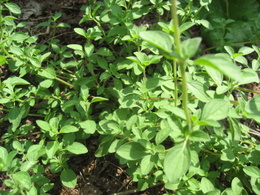Oregano Growing Guide
Oregano (Origanum vulgare) is a perennial herb in the mint family and is a close relative of marjoram. It is drought tolerant and is winter hardy in USDA Zones 5 to 9.
Oregano is native to the Mediterranean region and is a common herb used to flavor pizzas, tomato sauces and many Italian as well as other Mediterranean dishes.
Most gardeners are interested in the culinary varieties, but there are some ornamental varieties that can add some interest to your garden.
It can be easily grown in containers outdoors as well as indoors in a very sunny window or under grow lights.
Soil Preparation
The soil should be nice loose well drained organic garden soil with the soil pH between 6.0 to 8.0. As soon as the soil is frost-free and can be worked, till the soil by digging down 8 to 12-inches turning the soil over with a garden fork. Remove any large rocks and stones. The small stones remaining will do no harm and actually benefit the soil by adding some micronutrients to the soil.
Starting From Seed
Oregano can be started indoors 6-weeks before your last expected frost date. Most gardeners prefer to purchase it potted from garden centers.
Follow the instructions on the seed packet. Sow the seeds evenly and thinly in a sterile seed starting mix in cell packs or pots.
You can direct sow oregano in your herb garden in the late spring to early summer when the soil warms up a week or two after the last frost.
Sow the oregano seeds thinly and cover with ¼-inch of fine soil, keeping the soil moist. The soil needs to be warm and your oregano should germinate in a week or two. Thin the plants 12 to 18-inches apart. Keep the soil moist and remove any weeds.
For more detailed information visit the seed starting page.
Planting Oregano
Plant oregano in full sun directly in the garden after all danger of frost is past. The soil should be warm and it will do best if planted about 2-weeks after your last expected frost date.
Plant it in rows 12 to 18-inches apart. Depending on the variety, allowing them to crowd each other a bit will keep the weeds down and help support each other. After planting water give them some water.
Watering and Care
When the plants are a few inches tall add a nice loose mulch of shredded leaves or pine straw to shade the plant roots. This will keep the weeds out, the soil cooler and help retain moisture. Keep the mulch a couple of inches away from the stem. During dry spells give some water each week.
Harvesting Oregano
The leaves can be picked at any point in the growing season. Individual leaves should be carefully clipped off making sure that the oregano plant roots are not disturbed.
Pinch off any flower buds that form to keep the plant from bolting. This will encourage branching and the formation of more oregano leaves. It tastes best before the plant bolts and starts to flower.
Fresh leaves can keep for a few days in the refrigerator by rolling the leaves in a damp paper towel.
Drying Oregano
The leaves can be easily preserved by drying. When you dry your excess leaves that you grow during the summer months you can enjoy and have a steady supply during the winter and spring.
There are several methods of drying oregano. If you are in a warm, dry, low humidity location, you can dry oregano in the sun or in a dry barn or a shed. A very good method of drying oregano leaves is using a food dehydrator following your unit’s directions. Check occasionally for dryness, which may take several hours. When the leaves are brittle and crumbly when you press on them, they are done.
For most gardeners the easiest and fastest way is to dry in the oven. Pick your leaves after the dew has dried. To avoid having to remove the dried stems after drying, it is easier to cut them off before drying. Discard any discolored or bruised leaves. The leaves should be dry before putting in the oven. Place a thin layer of whole or cut leaves on a parchment lined cookie sheet and place in the oven at a very low temperature setting. Leave the door slightly open.
If the temperature is too high, the leaves may turn brown. Keeping the temperature around 200-degrees F or slightly lower, your dried oregano leaves will have nice green color. When dried, the oregano leaves will be brittle and crumbly when you press on them. Check occasionally for dryness. The time it takes may be an hour or so depending on temperature and the amount of leaves you are drying.
When the leaves are fully dried, they can be stored in a tightly sealed Mason jar in a dark location.
Diseases and Pests
Oregano can have root rot occur if the soil is poorly drained. Spider mites, whitefly and powdery mildew can occur in humid climates. The best control is to space the plants far enough apart to allow good air circulation.
Popular Oregano Varieties
Popular varieties: Italian, Greek, Mexican and Turkish oregano.
Sources: Seeds Now, Burpee, Park Seed
Garden Spikes newsletters give you timely information once or twice a month. Subscribe Free to the Garden Times newsletter below.
Your email address will only be used to send you a newsletter and will never be sold. You can unsubscribe at any time.

